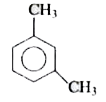Which one of the following gives onlyh one monochloro derivative?
neo-Pentane
n-Hexane
2-ethylpentane
3-Methylpentane
The correct Answer is:A
To determine which compound gives only one monochloro derivative, we need to analyze the structures of the given options and the types of hydrogen atoms present in each compound.
1. Identify the Compounds: The question provides four options:
- A) Neopentane
- B) n-Hexane
- C) 2-Ethylpentane
- D) 3-Methylpentane
2. Analyze Neopentane:
- Neopentane has the structure:
(CH3)4C
- In this structure, all the hydrogen atoms are attached to primary (1°) carbon atoms.
- Since there is only one type of hydrogen (1° hydrogen), neopentane can only form one monochloro derivative when one hydrogen is replaced by chlorine.
3. Analyze n-Hexane:
- n-Hexane has the structure:
CH3CH2CH2CH2CH2CH3
- This compound contains both primary (1°) and secondary (2°) hydrogen atoms.
- Therefore, it can form multiple monochloro derivatives, not just one.
4. Analyze 2-Ethylpentane:
- 2-Ethylpentane has the structure:
CH3CH(C2H5)CH2CH3
- This compound contains primary (1°), secondary (2°), and tertiary (3°) hydrogen atoms.
- Thus, it can also form multiple monochloro derivatives.
5. Analyze 3-Methylpentane:
- 3-Methylpentane has the structure:
CH3CH2C(CH3)CH2CH3
- Similar to 2-Ethylpentane, this compound contains primary (1°), secondary (2°), and tertiary (3°) hydrogen atoms.
- Therefore, it can form multiple monochloro derivatives as well.
6. Conclusion:
- Among the options analyzed, only neopentane gives one monochloro derivative because it has only primary hydrogen atoms.
- Therefore, the correct answer is A) Neopentane.
- A) Neopentane
- B) n-Hexane
- C) 2-Ethylpentane
- D) 3-Methylpentane
- Neopentane has the structure:
(CH3)4C
- In this structure, all the hydrogen atoms are attached to primary (1°) carbon atoms.
- Since there is only one type of hydrogen (1° hydrogen), neopentane can only form one monochloro derivative when one hydrogen is replaced by chlorine.
- n-Hexane has the structure:
CH3CH2CH2CH2CH2CH3
- This compound contains both primary (1°) and secondary (2°) hydrogen atoms.
- Therefore, it can form multiple monochloro derivatives, not just one.
- 2-Ethylpentane has the structure:
CH3CH(C2H5)CH2CH3
- This compound contains primary (1°), secondary (2°), and tertiary (3°) hydrogen atoms.
- Thus, it can also form multiple monochloro derivatives.
- 3-Methylpentane has the structure:
CH3CH2C(CH3)CH2CH3
- Similar to 2-Ethylpentane, this compound contains primary (1°), secondary (2°), and tertiary (3°) hydrogen atoms.
- Therefore, it can form multiple monochloro derivatives as well.
- Among the options analyzed, only neopentane gives one monochloro derivative because it has only primary hydrogen atoms.
- Therefore, the correct answer is A) Neopentane.
Topper's Solved these Questions
- BOOK - NCERT FINGERTPS ENGLISHCHAPTER - HYDROCARBONS EXERCISE - Higher Order Thinkin Skills7videos
HYDROCARBONS
- BOOK - NCERT FINGERTPS ENGLISHCHAPTER - HYDROCARBONS EXERCISE - Assertion & Reason15videos
HYDROCARBONS
- BOOK - NCERT FINGERTPS ENGLISHCHAPTER - EQUILIBRIUM EXERCISE - Assertion And Reason15videos
EQUILIBRIUM
- BOOK - NCERT FINGERTPS ENGLISHCHAPTER - HYDROGEN EXERCISE - Assertion And Reason15videos
HYDROGEN
Similar Questions
Knowledge Check
- Question 1 - Select One
Which one of the following is not a derived unit?
AJouleBwattCKilogramDnewton - Question 2 - Select One
Which one of the following compounds give only one isomer upon nitration ?
A B
B C
C D
D
Which one of the following functions is one-one?
View SolutionWhich of the following will give three mono-bromo derivatives excluding stereoisomers ?
View SolutionAn organic compound A(C4H6CI) on reation withNa/diethyl ether gives a hydrocarbon which on monochlorination gives only one chloro derivative A is .
View SolutionAn organic compound A(C4H9Cl) on the reaction with Na/diethly ether gives a hydrocarbon which on monochlorination gives only one chloro derivative then, A is
View SolutionWhich one of the following gives the correct description of a health disorder?
View SolutionWhich one of the following functions is not one-one?
View Solution

